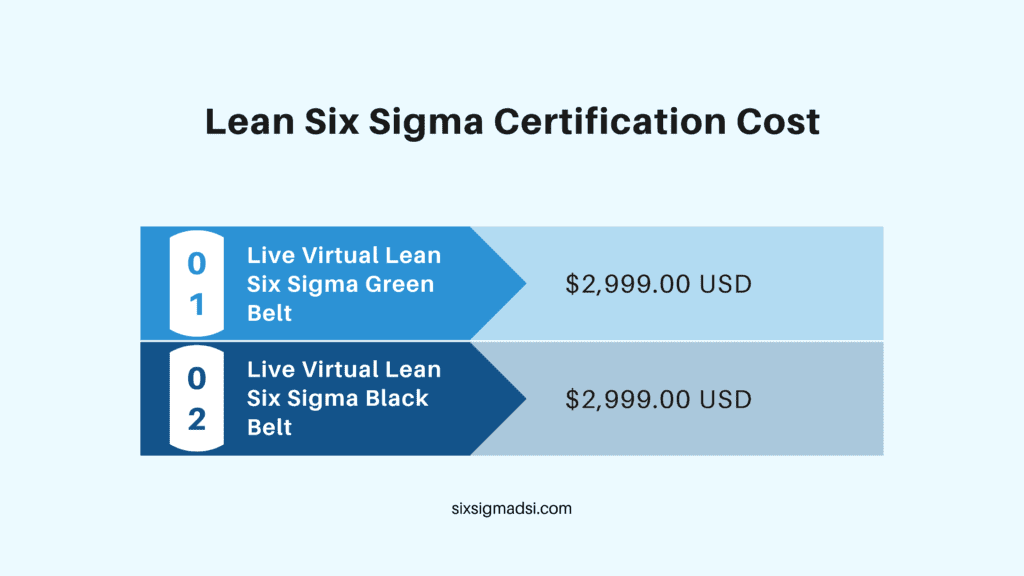Table of contents
- 5 Best Lean Six Sigma Courses
- 1. Six Sigma Development Solutions, Inc.
- 2. Lean Six Sigma Green Belt Certification (TUM)
- 3. Becoming a Six Sigma Green Belt (LinkedIn Learning)
- 4. Lean Six Sigma Green Belt E-Learning (ASQ)
- 5. Lean Six Sigma Green Belt Training and Certification (Pyzdek Institute)
- Benefits of Lean Six Sigma Training
- How Do I Get a Lean Six Sigma Certification?
- What is the Cost of Six Sigma Certification?
- Is Six Sigma Certification Worth it?
- Related articles
5 Best Lean Six Sigma Courses
Lean Six Sigma is a popular business analytics methodology. Businesses have used it extensively to reduce costs and improve customer satisfaction. The best online Lean Six (6) Sigma certification courses are those with great reviews and will be a great tool to help you advance your career and increase your chances of promotion and advancement.
You may find it difficult to choose from the many certification programs available. You may be wondering, “Where can I get six sigma certified?” Read on. This article lists some of the most accredited Lean Six Sigma and Six Sigma courses. These courses can help you advance your career by providing you with the basics of this topic as well as its applications across various industries.
1. Six Sigma Development Solutions, Inc.
Certified as an Accredited Training Organization (ATO) with the International Association of Six Sigma Certification (IASSC). You will learn alongside people from other companies in our fun, engaging Green Belt and Black Belt courses. With 5-star reviews, this is our top online lean six sigma course option.
- Trusted by over 400 Organizations Globally
- 17 Cities with Training Locations in the US and Globally
- Over 3500 Trained
2. Lean Six Sigma Green Belt Certification (TUM)
After each DMAIC stage, you will receive graded lean six sigma reviews on your documentation. You can also attend live online sessions every week to ask questions.
After completing the three first courses, paying learners will receive TUM Lean Six Sigma Yellow Belt certification. You can begin your Green Belt Certification Project in your final project after earning your Yellow Belt Certificate.
3. Becoming a Six Sigma Green Belt (LinkedIn Learning)
This learning path will teach you the basics of a Green Belt Certification. It is led by subject matter experts, such as Dr. Richard Chua. He is a professor and certified Lean Six Sigma, Master Black Belt Trainer.
The Six Sigma Specialization does NOT give learners “professional accreditation”. The successful completion of this Specialization will help you prepare for professional accreditation tests. This specialization does not require any previous experience.
4. Lean Six Sigma Green Belt E-Learning (ASQ)
This practical course, provided by the most recognized Six Sigma institution in certifications will teach you from experts around the world and Master Black Belt holders. This intermediate course does not require Yellow Belt Certification, but the prerequisite is 3-5 years of experience in an industry-specific position.
After completing the training, you are ready to take the CSSGB ASQ certification.
5. Lean Six Sigma Green Belt Training and Certification (Pyzdek Institute)
This interactive and comprehensive course will help you learn from subject matter experts. You will also take an online exam proctored by a Master Black Belt. Finally, you’ll complete a real project under the guidance of a Master Black Belt to demonstrate your knowledge of the Lean Six Sigma methodology.

Benefits of Lean Six Sigma Training
Six Sigma certifications will demonstrate to potential employers that your analytical skills are up-to-date and you possess the knowledge and skills necessary to identify problems, analyze and measure performance, improve processes, and make necessary adjustments. This training will give you an advantage over other candidates in your field. It can open doors for securing a job, a better salary, desirable positions, and promotions.
Six Sigma training will help you to develop the skills needed to succeed in today’s highly competitive business environment. You will maximize your time and resource value by learning to apply Six Sigma to your work. This will minimize waste and errors. You can also demonstrate your commitment to high quality in all of your products, services, and projects.
Accredited vs. Non-Accredited
You will need to choose the training program that best fits your career goals if you want to become Six Sigma certified. You will need to decide whether you are going to take a Six Sigma course that is accredited or not.
Some organizations claim that they are the official standard even though there isn’t a formal authority that regulates businesses that offer certification. There are some bodies that are considered to be the closest approximation of industry regulation.
- The Council for Six Sigma Certification accredits providers of training. CSSC is a leading professional body for Six Sigma certification.
- The American Society for Quality is a global-recognized organization that offers certification and training according to industry standards. It also maintains a registry of certification verification.
- Lean Six Sigma is accredited by the International Association of Six Sigma certification (IASSC).
You should be aware that enrolling in programs from non-accredited providers may reduce your chances of landing employment and progressing in your career. They may not have the same status on the job market and may not receive as much respect from other professionals.
Lean Six Sigma Professional Certification vs. University Certification
You must pass an exam at a recognized institution to be able to obtain a professional certificate. Both university-level certifications and professional certifications are valid for the majority of industries. You should check with your peers and employer to determine the best certification for you. ASQ and IASSC offer the most internationally recognized certifications. When choosing Lean Six Sigma training, make sure to choose courses that are aligned with the exams. Different certifications have different requirements. For example, ASQ Green Belt Certification will require 3 years of experience working on a Six Sigma Project, while IASSC does not require prior experience.
How Do I Get a Lean Six Sigma Certification?
You must pass an exam and enroll in a Six Sigma course to receive your certification. Some employers offer certifications directly to their employees. You can also enroll in a certification course that is offered by colleges, universities, or certification companies.
During your course, you will learn how to use Six Sigma in the real world. Many courses require you to complete a Six Sigma Project before taking your certification exam.
You will receive a Belt after passing the exam. They work a bit like karate, as you have to pass the first belt before moving on to the next. The majority of companies offer a Yellow Belt, Green Belt, Black Belt, and Master Black Belt.
What is the Cost of Six Sigma Certification?
Many companies offer their employees Six Sigma certification in-house or pay for it through a third party. People can earn their Six Sigma certification by taking the course themselves, without having to go through their employer.
You can take the course yourself, but be aware that certification costs vary from free to thousands. Most expensive courses include a virtual or in-person live teaching component and a detailed project.
There may be an additional fee for the test, as well as a cost associated with higher belts. Before choosing a course, make sure to check all the costs and discounts.

Is Six Sigma Certification Worth it?
An online Lean Six (6) Sigma certification course can help you make more money; according to a study by the American Society for Quality Reviews, Six Sigma-certified professionals earn an average of $16,411 more per year than other employees.
Are you ready to start your Lean Six Sigma Certification Course?
Leave a comment down below, we can help!



















